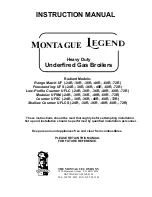
11
CAUTION
Under no circumstances should the mechanical room ever
be under a negative pressure. Particular care should be
taken where exhaust fan, attic fans, clothes dryers,
compressors, air handling units, etc., may take away air
from the unit.
2.2.2
EXHAUST FANS
Any fan or equipment which exhausts air from the equipment
room may deplete the combustion air supply and/or cause a
downdraft in the venting system through a barometric damper
if installed. Spillage of flue products from the venting system
into an occupied living space can cause a very hazardous
condition that must be immediately corrected.
2.3
OUTDOOR VENTING
The Dynaforce® windproof cabinet protects the unit from
weather, when fitted with the factory supplied air intake and UL
approved vent cap (93-0298), it will be self-venting and
suitable for outdoor installation.
1. Outdoor models must be installed outdoors and must use
the air intake and vent cap supplied by Camus®
Hydronics.
2. Periodically check to ensure that air intake and vent cap
are not obstructed.
3. Locate appliance at least 3 feet away from any overhang.
4. Locate appliance at least ten feet from building air intake.
5. Avoid installation in areas where runoff from adjacent
building can spill onto appliance.
For outdoor installations, always consider the use of a shelter
such as a garden shed in lieu of direct exposure of the
appliance to the elements. The additional protection afforded
by the shelter will help to minimize nuisance problems with
electrical connections and will allow easier servicing of the
appliance under severe weather conditions.
2.4
SIDEWALL VENTING
When fitted with the factory supplied vent terminal, the
Dynaforce® can vent up to 100 equivalent feet. Elbows can
range from 7 to 19 feet in equivalent length depending on
centreline radius. Refer to table 3 for vent sizes.
Appliances may be installed with either a horizontal sidewall
vent or vertical roof top vent. Terminals differ with each
application. Use single wall vent and seal all joints or use
pressure rated double wall vent.
When using single wall vent, all vent connector seams and
joints must be sealed with pressure sensitive aluminium tape
or silicone sealant as specified by the vent manufacturer.
Aluminium tape must meet the provisions of SMACNA AFTS-
100-73 Standard.
Periodically check to ensure that the vent terminal is
unobstructed.
This venting system uses the appliance’s internal combustion
air fan to force the flue products out horizontally.
The Dynaforce® fan generates a positive pressure in the flue.
Combustion air is drawn from the equipment room. Sidewall
terminations are available from the factory. Refer to local
codes for proper installation and location of vent terminals.
2.4.1
SIDEWALL VENT TERMINAL & SIDEWALL
INTAKE AIR TERMINAL
•
The sidewall vent terminal kit includes the wall
penetration assembly and the discharge screen
assembly.
•
The opening through the wall for installation of the
sidewall vent terminal must provide an air space
clearance of 1 inch (2.5cm) around the flue pipe. The
diameter of the opening for installation of the sidewall
vent terminal will be 2 inches (5cm) larger than the
nominal diameter of the installed vent pipe to the
sidewall vent cap. The diameter of the opening for the
air inlet cap will be the same as the nominal size of
the pipe.
•
Install the proper vent pipe to the vent terminal
(provided by Camus® Hydronics).
•
Follow all requirements in the General Venting
sections for venting flue products to the outdoors.
2.4.2
LOCATION
OF
A
SIDEWALL
VENT
TERMINATION
•
The vent terminal shall terminate at least 3 ft (1M)
above any forced air inlet within 10 ft (3M)
horizontally.
•
The vent terminal MUST NOT terminate below a
forced air intake at any distance.
•
Do not terminate the vent in a window well, stairwell,
alcove, courtyard or other recessed area. The vent
cannot terminate below grade.
•
The vent shall not terminate less than 7 ft above a
public walkway due to the normal formation of water
vapour in the combustion process.
•
The vent system shall terminate at least 3 foot (1M)
above grade, above normal snow levels and at least 7
ft (2.15M) above grade when located adjacent to
public walkways.
•
The vent terminal shall not be installed closer than 3 ft
(1M) from an inside corner of an L-shaped structure.
•
The vent terminal should have a minimum clearance
of 4 ft (1.25M) horizontally from and in no case above
or below, unless a 4 ft (1.25 m) horizontal distance is
maintained from electric meters, gas meters,
regulators and relief equipment. In all cases local
codes take precedence.
•
Flue gas condensate can freeze on exterior walls or
on the vent terminal. Frozen condensate on the vent
cap can result in a blocked flue condition. Some
discoloration to exterior building surfaces can be
expected. Adjacent brick or masonry surfaces should
be protected with a rust resistant sheet metal plate.
Summary of Contents for DRH300
Page 2: ......
Page 6: ......
Page 38: ...32 13 Place toggle switch setting to REMOTE for remote operation if required...
Page 69: ...63 PART 12 EXPLODED VIEW 19 1 2 3 4 5 6 7 8 9 10 11 12 13 14 15 16 17 18 20...
Page 70: ...64 21 22 23 24 26 35 34 33 32 31 30 29 28 27 25 36 37 38 39 40 42 43 56...
Page 77: ...71 PART 13 ELECTRICAL DIAGRAMS...
Page 78: ...72...
Page 79: ...73...
Page 81: ...75...
Page 82: ...76...
Page 83: ...77...
Page 86: ......
















































